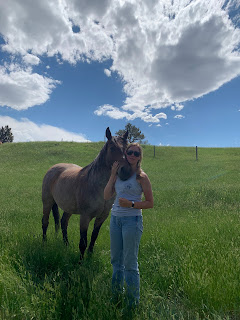Collaboration and Relationships
Post by 2022 student Kira Maier -
Once again, I had very little experience with soils except for a small class in High School. The past couple of days, we have talked about the importance of soil health and its effect on the pasture plants. I was taught in high school how to take soil samples, but this is the first time that I am physically doing it. During this section of our class, I get to turn my limited knowledge into ample experience.
Plants need the elements nitrogen, potassium, and phosphorus from the soil to grow. Every plant needs different amounts of each element, so plants can be a useful tool to estimate the amount in the soil. For example, if there are a lot of legumes in the area, that means nitrogen is low in the soil. Legumes are nitrogen fixers, so they have microorganisms in their roots which have the ability to fix nitrogen, which provide the plant with nitrogen. Also, non-mycorrhizal plants who can survive only on phosphorus show that the soil is rich in phosphorus. We had Meriel Beck, the Musselshell County weed coordinator, come out to talk to us about the different invasive and native species they have here in the area. It’s a constant battle here to keep native species and eradicate invasive species because what happens to the soil plays a big role in which species has the advantage in their growing season. For example, to stop the fire from spreading they created fire breaks along the roadsides. They kill all the plants in that row and stomp down the soil as best they can to create an area with no fuel. 2 years later after the fire, that ground is still bare, but you can see that weeds are popping up a little here and there. They have a greater advantage growing in those areas because the soil is unfriendly to native species, but they are more durable. We also met with Landon Krogstead who is a range management expert that works for the NRCS. He helped us identify the plants that are most helpful and which plants are least helpful to have on the range in terms of cattle production.
Signs of life is also a good indicator of soil health. Microorganisms are needed to cycle nutrients and stimulate plant growth. They are a large part of the plant’s life cycle. Larger organisms like earth worms and insects are just as important. They burrow holes in the ground which aerates the soil and allows a flow of gases to the plants. We were working with Jeb Eberly from Montana State Research station. He’s helping us test our soil for DNA. With the samples we collected, we should be able to figure out what kind of microbials and fungi are in the soil. It was interesting to talk to them about their methods of surveying versus our method of surveying. They used a small bucket with a metal tube in the middle where the drill goes in to drill out the soil. We had the same system but theirs worked better, so we ended up using theirs. Jeb explained that the soil where they are is much drier than our soil here, so that can affect the ease of sampling and the data we get from it. They have a much larger sampling area than we do too. Their plots are 10 acres, and they have smaller subplots in which they collect the soil. I hope in the future we would be able to compare the soil in the Roundup area with the soil near Montana State. I am excited to start and continue this relationship with Montana State.



